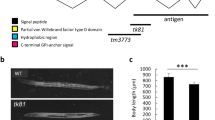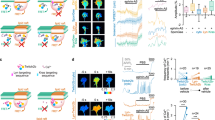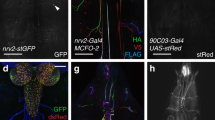Abstract
Netrins are secreted axon guidance molecules required for commissure formation in a wide range of animal species, including Caenorhabditis elegans, Drosophila melanogaster and mice. They are generally thought to function as chemoattractants, acting at a distance to direct commissural axon growth toward the midline of the central nervous system. We show here, however, that D. melanogaster commissural axons still orient normally and reach the midline even in the complete absence of netrins, though some of them fail to cross the midline. Tethering endogenous netrin to the membrane selectively disrupts its long-range but not short-range activity, yet still allows normal commissure formation. We therefore propose that netrins act in commissural axon guidance as short-range cues that promote midline crossing, not as long-range chemoattractants.
This is a preview of subscription content, access via your institution
Access options
Subscribe to this journal
Receive 12 print issues and online access
$209.00 per year
only $17.42 per issue
Buy this article
- Purchase on Springer Link
- Instant access to full article PDF
Prices may be subject to local taxes which are calculated during checkout






Similar content being viewed by others
References
Yu, T.W. & Bargmann, C.I. Dynamic regulation of axon guidance. Nat. Neurosci. 4, 1169–1176 (2001).
Dickson, B.J. Molecular mechanisms of axon guidance. Science 298, 1959–1964 (2002).
Huber, A.B., Kolodkin, A.L., Ginty, D.D. & Cloutier, J.F. Signaling at the growth cone: ligand-receptor complexes and the control of axon growth and guidance. Annu. Rev. Neurosci. 26, 509–563 (2003).
Tessier-Lavigne, M. & Goodman, C.S. The molecular biology of axon guidance. Science 274, 1123–1133 (1996).
Zecca, M., Basler, K. & Struhl, G. Direct and long-range action of a wingless morphogen gradient. Cell 87, 833–844 (1996).
Nellen, D., Burke, R., Struhl, G. & Basler, K. Direct and long-range action of a DPP morphogen gradient. Cell 85, 357–368 (1996).
Strigini, M. & Cohen, S.M. A hedgehog activity gradient contributes to AP axial patterning of the Drosophila wing. Development 124, 4697–4705 (1997).
Entchev, E.V., Schwabedissen, A. & Gonzalez-Gaitan, M. Gradient formation of the TGF-beta homolog Dpp. Cell 103, 981–991 (2000).
Teleman, A.A. & Cohen, S.M. Dpp gradient formation in the Drosophila wing imaginal disc. Cell 103, 971–980 (2000).
Briscoe, J., Chen, Y., Jessell, T.M. & Struhl, G. A hedgehog-insensitive form of patched provides evidence for direct long-range morphogen activity of sonic hedgehog in the neural tube. Mol. Cell 7, 1279–1291 (2001).
Williams, P.H., Hagemann, A., Gonzalez-Gaitan, M. & Smith, J.C. Visualizing long-range movement of the morphogen Xnr2 in the Xenopus embryo. Curr. Biol. 14, 1916–1923 (2004).
Belenkaya, T.Y. et al. Drosophila Dpp morphogen movement is independent of dynamin-mediated endocytosis but regulated by the glypican members of heparan sulfate proteoglycans. Cell 119, 231–244 (2004).
Serafini, T. et al. The netrins define a family of axon outgrowth-promoting proteins homologous to C. elegans UNC-6. Cell 78, 409–424 (1994).
Ishii, N., Wadsworth, W.G., Stern, B.D., Culotti, J.G. & Hedgecock, E.M. UNC-6, a laminin-related protein, guides cell and pioneer axon migrations in C. elegans. Neuron 9, 873–881 (1992).
Harris, R., Sabatelli, L.M. & Seeger, M.A. Guidance cues at the Drosophila CNS midline: identification and characterization of two Drosophila Netrin/UNC-6 homologs. Neuron 17, 217–228 (1996).
Mitchell, K.J. et al. Genetic analysis of Netrin genes in Drosophila: Netrins guide CNS commissural axons and peripheral motor axons. Neuron 17, 203–215 (1996).
Kennedy, T.E., Serafini, T., de la Torre, J.R. & Tessier-Lavigne, M. Netrins are diffusible chemotropic factors for commissural axons in the embryonic spinal cord. Cell 78, 425–435 (1994).
Colamarino, S.A. & Tessier-Lavigne, M. The axonal chemoattractant netrin-1 is also a chemorepellent for trochlear motor axons. Cell 81, 621–629 (1995).
Hopker, V.H., Shewan, D., Tessier-Lavigne, M., Poo, M. & Holt, C. Growth-cone attraction to netrin-1 is converted to repulsion by laminin-1. Nature 401, 69–73 (1999).
Chan, S.S. et al. UNC-40, a C. elegans homolog of DCC (Deleted in Colorectal Cancer), is required in motile cells responding to UNC-6 netrin cues. Cell 87, 187–195 (1996).
Keino-Masu, K. et al. Deleted in Colorectal Cancer (DCC) encodes a netrin receptor. Cell 87, 175–185 (1996).
Kolodziej, P.A. et al. frazzled encodes a Drosophila member of the DCC immunoglobulin subfamily and is required for CNS and motor axon guidance. Cell 87, 197–204 (1996).
Stein, E., Zou, Y., Poo, M. & Tessier-Lavigne, M. Binding of DCC by netrin-1 to mediate axon guidance independent of adenosine A2B receptor activation. Science 291, 1976–1982 (2001).
Leung-Hagesteijn, C. et al. UNC-5, a transmembrane protein with immunoglobulin and thrombospondin type 1 domains, guides cell and pioneer axon migrations in C. elegans. Cell 71, 289–299 (1992).
Hamelin, M., Zhou, Y., Su, M.W., Scott, I.M. & Culotti, J.G. Expression of the UNC-5 guidance receptor in the touch neurons of C. elegans steers their axons dorsally. Nature 364, 327–330 (1993).
Leonardo, E.D. et al. Vertebrate homologues of C. elegans UNC-5 are candidate netrin receptors. Nature 386, 833–838 (1997).
Ackerman, S.L. et al. The mouse rostral cerebellar malformation gene encodes an UNC-5-like protein. Nature 386, 838–842 (1997).
Keleman, K. & Dickson, B.J. Short- and long-range repulsion by the Drosophila Unc5 netrin receptor. Neuron 32, 605–617 (2001).
Hong, K. et al. A ligand-gated association between cytoplasmic domains of UNC5 and DCC family receptors converts netrin-induced growth cone attraction to repulsion. Cell 97, 927–941 (1999).
Serafini, T. et al. Netrin-1 is required for commissural axon guidance in the developing vertebrate nervous system. Cell 87, 1001–1014 (1996).
Hedgecock, E.M., Culotti, J.G. & Hall, D.H. The unc-5, unc-6, and unc-40 genes guide circumferential migrations of pioneer axons and mesodermal cells on the epidermis in C. elegans. Neuron 4, 61–85 (1990).
Wadsworth, W.G., Bhatt, H. & Hedgecock, E.M. Neuroglia and pioneer neurons express UNC-6 to provide global and local netrin cues for guiding migrations in C. elegans. Neuron 16, 35–46 (1996).
Winberg, M.L., Mitchell, K.J. & Goodman, C.S. Genetic analysis of the mechanisms controlling target selection: complementary and combinatorial functions of netrins, semaphorins, and IgCAMs. Cell 93, 581–591 (1998).
Higashijima, S., Shishido, E., Matsuzaki, M. & Saigo, K. eagle, a member of the steroid receptor gene superfamily, is expressed in a subset of neuroblasts and regulates the fate of their putative progeny in the Drosophila CNS. Development 122, 527–536 (1996).
Dittrich, R., Bossing, T., Gould, A.P., Technau, G.M. & Urban, J. The differentiation of the serotonergic neurons in the Drosophila ventral nerve cord depends on the combined function of the zinc finger proteins Eagle and Huckebein. Development 124, 2515–2525 (1997).
Schmid, A., Chiba, A. & Doe, C.Q. Clonal analysis of Drosophila embryonic neuroblasts: neural cell types, axon projections and muscle targets. Development 126, 4653–4689 (1999).
Greco, V., Hannus, M. & Eaton, S. Argosomes: a potential vehicle for the spread of morphogens through epithelia. Cell 106, 633–645 (2001).
Panakova, D., Sprong, H., Marois, E., Thiele, C. & Eaton, S. Lipoprotein particles are required for Hedgehog and Wingless signalling. Nature 435, 58–65 (2005).
Charron, F., Stein, E., Jeong, J., McMahon, A.P. & Tessier-Lavigne,, M. The morphogen sonic hedgehog is an axonal chemoattractant that collaborates with netrin-1 in midline axon guidance. Cell 113, 11–23 (2003).
Augsburger, A., Schuchardt, A., Hoskins, S., Dodd, J. & Butler, S. BMPs as mediators of roof plate repulsion of commissural neurons. Neuron 24, 127–141 (1999).
Butler, S.J. & Dodd, J. A role for BMP heterodimers in roof plate-mediated repulsion of commissural axons. Neuron 38, 389–401 (2003).
Hao, J.C. et al. C. elegans Slit acts in midline, dorsal-ventral, and anterior-posterior guidance via the SAX-3/Robo receptor. Neuron 32, 25–38 (2001).
de Anda, F.C. et al. Centrosome localization determines neuronal polarity. Nature 436, 704–708 (2005).
Rong, Y.S. & Golic, K.G. Gene targeting by homologous recombination in Drosophila. Science 288, 2013–2018 (2000).
Rong, Y.S. et al. Targeted mutagenesis by homologous recombination in D. melanogaster. Genes Dev. 16, 1568–1581 (2002).
Patel, N.H. Imaging neuronal subsets and other cell types in whole-mount Drosophila embryos. in Drosophila Melanogaster: Practical Uses in Cell and Molecular Biology (eds. Goldstein, L.S.B. & Fyrberg, E.A.) 445–487 (Academic Press, San Diego, 1994).
Seeger, M., Tear, G., Ferres-Marco, D. & Goodman, C.S. Mutations affecting growth cone guidance in Drosophila: genes necessary for guidance toward or away from the midline. Neuron 10, 409–426 (1993).
Van Vactor, D., Sink, H., Fambrough, D., Tsoo, R. & Goodman, C.S. Genes that control neuromuscular specificity in Drosophila. Cell 73, 1137–1153 (1993).
Bopp, D., Bell, L.R., Cline, T.W. & Schedl, P. Developmental distribution of female-specific Sex-lethal proteins in Drosophila melanogaster. Genes Dev. 5, 403–415 (1991).
Bossing, T. & Technau, G.M. The fate of the CNS midline progenitors in Drosophila as revealed by a new method for single cell labelling. Development 120, 1895–1906 (1994).
Acknowledgements
We thank C. Rickert and G. Technau for their skill, patience and hospitality in teaching M.B. how to perform DiI labeling; A. Graf and K. Paiha for technical assistance; and F. Schnorrer and G. Gilestro for comments on the manuscript. We also thank the Drosophila Genetic Resource Center in Kyoto and the Gene Disruption Project for P-element stocks. This work was supported by a grant from the Austrian Science Fund.
Author information
Authors and Affiliations
Corresponding author
Ethics declarations
Competing interests
The authors declare no competing financial interests.
Supplementary information
Supplementary Fig. 1
Targeting NetB. (PDF 67 kb)
Supplementary Video 1
ato axons in wild-type embryos. Time-lapse of an ato-GAL4 UAS-mCD8-GFP embryo, showing ato sensory axons entering and arborizing within the CNS. The embryo was scanned at 90-second intervals, from stage 14 until stage 16 (total time 2:22:30). (MOV 2325 kb)
Supplementary Video 2
ato axons expressing Unc5 in NetAΔNetBmyc. embryos. Time-lapse of a NetAΔ NetBmyc. ato-GAL4 UAS-Unc5 UAS-mCD8-GFP embryo, showing ato sensory axons extending toward but not entering the CNS. The embryo was scanned at 90-second intervals, from stage 14 until stage 16 (total time 2:22:30). (MOV 2394 kb)
Supplementary Video 3
ato axons expressing Unc5 in NetAΔNetB™. embryos. Time-lapse of a NetAΔ NetB™. ato-GAL4 UAS-Unc5 UAS-mCD8-GFP embryo, showing ato sensory axons entering and arborizing within the CNS. The embryo was scanned at 90-second intervals, from stage 14 until stage 16 (total time 2:22:30). (MOV 2322 kb)
Rights and permissions
About this article
Cite this article
Brankatschk, M., Dickson, B. Netrins guide Drosophila commissural axons at short range. Nat Neurosci 9, 188–194 (2006). https://doi.org/10.1038/nn1625
Received:
Accepted:
Published:
Issue Date:
DOI: https://doi.org/10.1038/nn1625
This article is cited by
-
Asymmetric activity of NetrinB controls laterality of the Drosophila brain
Nature Communications (2023)
-
Further confirmation of netrin 1 receptor (DCC) as a depression risk gene via integrations of multi-omics data
Translational Psychiatry (2020)
-
The Netrin-1/DCC guidance system: dopamine pathway maturation and psychiatric disorders emerging in adolescence
Molecular Psychiatry (2020)
-
Drosophila Netrin-B controls mushroom body axon extension and regulates courtship-associated learning and memory of a Drosophila fragile X syndrome model
Molecular Brain (2019)
-
Roles of axon guidance molecules in neuronal wiring in the developing spinal cord
Nature Reviews Neuroscience (2019)



